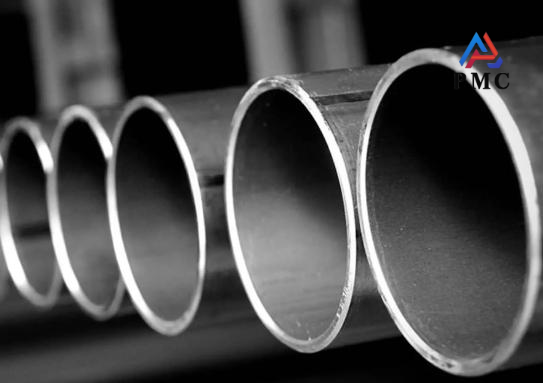
Stainless Steel Welded Pipe VS Carbon Steel Welded Pipe
Stainless steel welded pipes are made by welding steel or steel strips after curling and forming by machines and dies. Chromium is a key element in its composition, and its content is usually above 10.5%. For example, the common 304 stainless steel has a chromium content of 18-20%. It also contains a certain amount of nickel and other alloy elements. Taking 304 as an example, the nickel content is 8-10.5%.
Carbon steel welded pipes are made of carbon steel through welding technology. The main components are iron and carbon. The carbon content is generally below 2.11%, and it contains small amounts of silicon, manganese, sulfur, phosphorus and other elements. According to the carbon content, carbon steel can be divided into low carbon steel (carbon content less than 0.25%), medium carbon steel (carbon content 0.25% - 0.6%) and high carbon steel (carbon content greater than 0.6%). Different carbon contents make the performance of carbon steel welded pipes different.
Performance characteristics comparison
1. Corrosion resistance
Stainless steel welded pipes have strong corrosion resistance due to the effect of alloy elements. For example, in the chemical industry, which is often exposed to various acid and alkali solutions, 316L stainless steel welded pipes can be used stably for a long time and resist corrosion.
Carbon steel welded pipes are not so "durable" and are prone to rust and corrosion in humid air, water and other environments. Therefore, in order to improve the corrosion resistance of carbon steel welded pipes, anti-corrosion measures such as painting and galvanizing are usually taken.
2. Strength and hardness
Carbon steel welded pipe has the characteristics of high strength and high hardness. In the field of construction, it is often used to build the framework of building structures, such as the main structure of ordinary residential and commercial buildings, which can withstand the weight of the building itself and various external forces.
Stainless steel welded pipes are also good in strength and hardness. Some special stainless steel welded pipes have strength that can meet the requirements of the aerospace field.
3. Processing performance
Carbon steel welded pipe has good welding performance and is easy to process. At the construction site, construction workers can easily cut and weld carbon steel welded pipes, and can process them into various shapes and sizes according to actual needs to meet the needs of different projects.
Stainless steel welded pipes are relatively difficult to process because they contain many alloy elements. During the processing, they are prone to work hardening, which increases the difficulty and cost of processing. However, stainless steel welded pipes also have unique advantages in certain processing techniques. For example, when using advanced laser cutting technology, high-precision, high-quality cutting surfaces can be obtained, and the heat-affected zone is small, which can meet the needs of some industries with high requirements for processing accuracy.

Differences in application areas
1. Stainless steel welded pipes are widely used in piping systems in the food, beverage and pharmaceutical industries due to their excellent corrosion resistance and hygienic properties. In the chemical industry, various highly corrosive fluids are often transported. Stainless steel welded pipes can operate stably for a long time, reduce maintenance costs and improve production efficiency.
2. Carbon steel welded pipes play an important role in the fields of petroleum, chemical industry, electric power, building structure, etc. due to their high strength and good welding performance. In the oil and gas industry, it is often used in the extraction, transportation and processing of oil and gas to build pipeline systems for transporting oil, gas and other media; in the power industry, it is used to build pipeline systems for equipment such as boilers and steam turbines.
Price and cost comparison
In terms of price, carbon steel welded pipes usually have more cost advantages than stainless steel welded pipes. The raw material of carbon steel welded pipe is mainly carbon steel, which has a wide range of sources, relatively low cost, and a relatively simple production process, which further reduces the cost.
Stainless steel welded pipes contain alloy elements such as chromium and nickel, which are more expensive, and the production process is more complicated, making the processing difficult and the processing cost increase accordingly, resulting in their prices being much higher than carbon steel welded pipes.
How to choose the right welded pipe?
In practical applications, it is very important to choose the right welded pipe. If it is in the food, medicine and other industries with extremely high requirements for hygiene and corrosion resistance, stainless steel welded pipe is undoubtedly the best choice to ensure product quality and safety. If it is in ordinary building structures, general fluid transportation and other scenes with low requirements for corrosion resistance, carbon steel welded pipe is an economical and practical choice due to its cost advantage and good strength performance.
When choosing, you also need to consider the budget factor. If the budget is limited and the use environment does not have particularly harsh requirements on the performance of welded pipes, carbon steel welded pipes are a good choice; if the budget is sufficient and there are high requirements for product performance, stainless steel welded pipes can better meet long-term use needs. At the same time, you should also pay attention to the quality of the product and the reputation of the supplier(Permanent Steel Manufacturing Co.,Ltd), and choose a supplier with quality assurance and good reputation to ensure that you buy products that meet the standards.
Read more: Stainless Steel Welded Pipe vS. Stainless Steel Seamless Pipe


